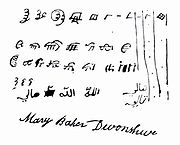Carabou
Princess Carabu from Javasu - English Princess Caraboo (* 1791 in Witheridge , Devonshire , † January 4, 1865 in Bristol ); actually Mary Baker , nee Willcocks , was a well-known impostor in early 19th century England .
The princess
On the evening of April 13, 1817, the poor overseer in the town of Almondsbury in Gloucestershire, south-west England, brought a young woman to the justice of the peace, Samuel Worrall . She was dressed exotic, seemed to speak an unfamiliar language and made herself understandable only by showing hands. In the next few weeks she was asked repeatedly, but more than her name Carabu and a possible origin from the Far East could not be found out of her.
That changed when a Portuguese named Manuel Eynesso , who had lived in Malaya , was brought in to see her. He seemed to be able to communicate with her and reported that she was a Chinese-Malay princess from Javasu who had been kidnapped by pirates and sold as a slave. After weeks of voyage by ship, she jumped overboard and landed on English soil.
In the weeks that followed, the liberated “princess” was introduced to “good company”. Journalists and scientists questioned them and Carabu reported on the living conditions of their country, their god Allah Tallah , drew a map of their trip and wrote down the alphabet and numbers in their "native language". It was also drawn for an article in the daily newspaper in nearby Bristol . Then a woman from Bristol answered who recognized her former lodger in Carabu. Faced with the truth, Carabu then admitted the fraud.
Mary Baker
In reality, Carabu was born Mary Wilcox in Witheridge, Devonshire. At the age of 16, the illiterate woman was given to a local family as a maid. Two years later she ran away, first to Exeter , then on to Bristol and London , where she worked with a family for three years and learned to read and write. Dismissed after a theft, she then disguised as a man and lived among muggers for a while. Back in London she married a Mr. Baker who told her a lot about his Far Eastern travels. When her husband suddenly disappeared, she set off for Bristol to emigrate to America. Since she didn't have the money for the crossing, she turned into "Princess Carabu" in order to gain access to a wealthy family and steal the necessary cash there.
Mary Baker might not have played her role as Carabu for so long had it not been for chance in the form of Manuel Eynesso. He immediately recognized her as an impostor, but acted as her “interpreter” against a profit sharing of 50 percent.
Amazingly, she was not handed over to the police, but was allowed to stay in the Woralls house. The stream of visitors who now wanted to see the “Female Psalmanazar ” did not stop, she was portrayed and a book about her was published. At the end of June 1817, her trip to America was financed and she disappeared in the direction of Philadelphia . In 1824 she was back in London. Here she first marketed her fading fame as "Princess Carabu" for an entrance fee, then remarried and lived as a housewife in Bristol until her death.
There were reports in the contemporary press that instead of going to America, Carabu landed on St. Helena , where she became Napoleon's last great love . A look at Napoleon's literature is enough to expose this story as a satirical joke by a newspaper journalist.
Movie
The American feature film Princess Caraboo from 1994 is based on Mary Baker's freely retold story ; Directed by Michael Austin , with Phoebe Cates (as "Caraboo"), Jim Broadbent , Wendy Hughes , John Lithgow , Jerry Hall and Kevin Kline .
literature
- John Matthew Gutch: Caraboo: A Narrative of a Singular Imposition . London 1817, resologist.net
- Egon Larsen : Carabu from Javasu . In: Ders .: impostor . Ernst Kabel, Hamburg 1984, ISBN 3-921909-42-2 , pp. 73-87
- John Wells: Princess Caraboo: Her True Story . Pan Books, London 1994, ISBN 0-330-33630-4
- Jennifer Raison, Michael Goldie: Caraboo. The Servant Girl Princess . The Windrush Press, Moreton-in-Marsh 1994
Web links
- Brian A. Haughton: Mary Willcocks & the Princess Caraboo Hoax
- Brian A. Haughton: Bristol's Princess Caraboo
- contemporary publications on Princess Carabu on Google Books
| personal data | |
|---|---|
| SURNAME | Carabou |
| ALTERNATIVE NAMES | Caraboo; Baker, Mary (real name); Willcocks, Mary (maiden name) |
| BRIEF DESCRIPTION | English impostor |
| DATE OF BIRTH | 1791 |
| PLACE OF BIRTH | Witheridge , Devonshire |
| DATE OF DEATH | January 4, 1865 |
| Place of death | Bristol |

